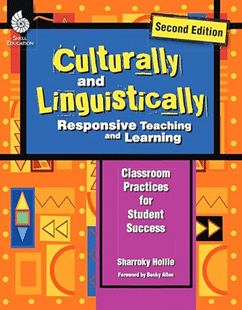Theories of culturally relevant instruction began to appear in the academic literature nearly half a century ago (e.g. Cazden & Leggett, 1981; Au & Jordan, 1981; Delpit, 1988). Since then, Culturally Responsive Teaching (Gay, 2000) and Culturally Relevant Pedagogy (Ladson-Billings, 1995) emerged as prominent research frameworks. Both perspectives support the view that compulsory education should further social justice and societal change (two tenets of democracy) for all students – not just English Learners or speakers of unstandardized dialects (Aronson & Laughte, 2016).
Evidence-based, culturally responsive instruction incorporates an appreciation and consideration of language variation (Hollie, 2017) along with the importance of validating and affirming every aspect of a student’s culture — not just race and ethnicity (Gay, 2010). And because language and culture are inseparable, understanding differing discourse styles is also a central aspect of cultural responsiveness (Foster, 1995).
In a culturally responsive classroom, teachers establish high expectations for every student while taking into account students’ linguistic, home and academic backgrounds (Delpit, 1988). Simply understanding the language demands in learning tasks can improve academic achievement, boost engagement and help students to feel understood and appreciated. Culturally responsive teaching also mediates cultural and linguist bias — the tendency to interpret students’ communication and behavior through our own cultural viewpoints and assumptions. Like language variation, most Americans (including educators!) are not taught about differing cultural beliefs and practices in school.

Dr. Sharroky Hollie, Executive Director of the of the Center for Culturally Responsive Teaching and Learning (CCRTL), presents an overview of Culturally and Linguistically Responsive (CLR) instruction with the goal of building and bridging students to success in academia and mainstream culture.
References
Cazden, C., & Leggett, E. (1981). Culturally responsive education: Recommendations for achieving Lau remedies II. In H. T. Trueba, G. P. Guthrie, & K. Au (Eds.), Culture and the bilingual classroom: Studies in classroom ethnography (pp. 69-86). Rowley, MA: Newbury House
Au K., Jordan C. (1981). Teaching reading to Hawaiian children: Finding a culturally appropriate solution. In Trueba H. T., Guthrie G. P., Au K. (Eds.), Culture and the bilingual classroom: Studies in classroom ethnography (pp. 139–152). Rowley, MA: Newbury.
Gay, G. (2000). Culturally responsive teaching: Theory, research, and practice. New York, New York: Teachers College Press.
Ladson-Billings, Gloria (1995a). Toward a theory of culturally relevant pedagogy. American Research Journal. 32(3) 465-491.
Aronson, B., & Laughter, J. (2016). The Theory and Practice of Culturally Relevant Education: A Synthesis of Research Across Content Areas. Review of Educational Research, 86(1), 163-206. https://doi.org/10.3102/0034654315582066
Sharroky Hollie, Culturally and Linguistically Responsive Teaching and Learning-Classroom Practices for Student Success, Shell Education (2017).
Gay, Geneva (2010). Culturally responsive teaching: Theory, Research, and Practice (2nd ed.). New York, New York: Teachers College Press.
Foster, M. (1995). African American teachers and culturally relevant pedagogy. In J. A. Banks & C. A. M. Banks (Eds.), Handbook of research on multicultural education (pp. 570-581). New York: Macmillan
Delpit, L. (1988). The silenced dialogue: Power and pedagogy in educating other people’s children. Harvard Educational Review, 58, 280-298